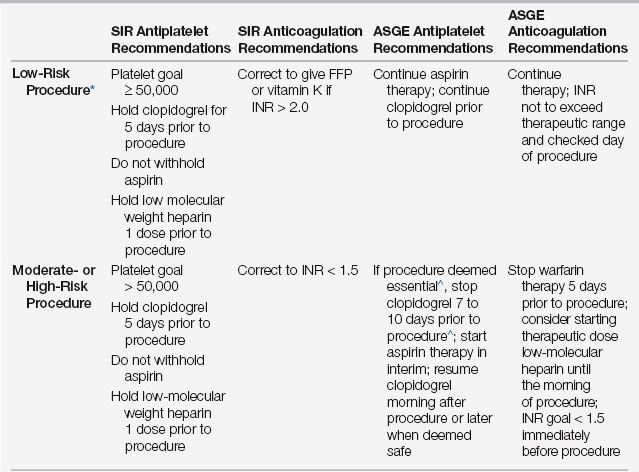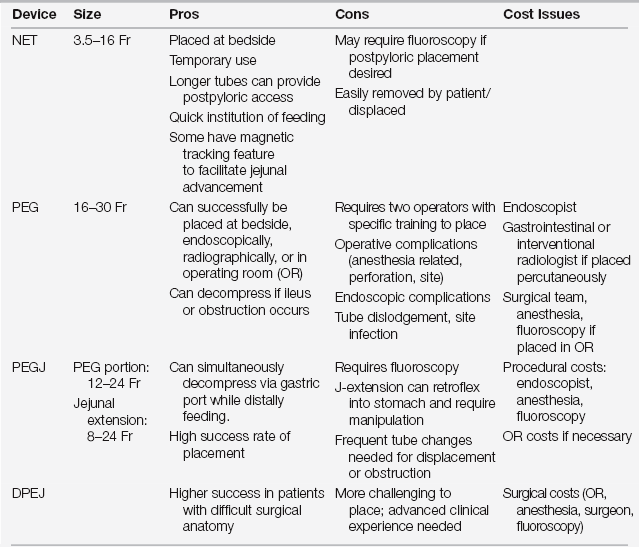Chapter 16
Nutrition-Related Access Procedures
Indications
Primarily, long-term enteral feeding tubes are indicated for patients who are intubated for respiratory failure or who have impaired swallowing caused by neurologic conditions (either organic or medication induced); head or facial trauma; luminal obstruction from malignancy or other strictures; motility issues such as gastroparesis; and hypercatabolic states such as cystic fibrosis, extensive burn injury, and Crohn’s disease. Enteral tubes can also be used for hydration and medication administration. Furthermore, PEG tubes may be chosen for gastric decompression in the setting of severe gastroparesis or non operable intestinal obstruction.
Preprocedure Assessment
Anticoagulant and Antiplatelet Therapy
The American Society for Gastrointestinal Endoscopy (ASGE) and the Society of Interventional Radiology (SIR) issued recommendations regarding the management of anticoagulation or antiplatelet therapy for patients undergoing enteral access procedures (see Table 16.1). The ASGE defines a low-risk procedure as one that includes routine use of endoscopy or fluoroscopy without any percutaneous incision or puncture made. A high-risk procedure includes any enteral access technique that involves an incision or establishment of a fresh stoma (i.e., all new PEG tube insertions). Risk also relates to the probability of a thromboembolic event occurring should the anticoagulation or antiplatelet therapy be stopped before the procedure.
TABLE 16.1

FFP, fresh frozen plasma; INR, International Normalized Ratio; LMWH, low molecular weight heparin.
∗SIR regards initial gastrostomy placement as a moderate-risk procedure
^Consider postponing elective procedure in patients with high thromboembolic risk
Modified from Nikolic B, et al: Consensus guidelines for periprocedural management of coagulation status and hemostasis risk in percutaneous image-guided interventions. J Vasc Interv Radiol 23:727–736, 2012 and American Society for Gastrointestinal Endoscopy Standards of Practice Committee. Management of antithrombotic agents for endoscopic procedures. Gastrointestinal Endoscopy 70:1060-1070, 2009.
Antibiotic Prophylaxis
Patients undergoing gastrostomy placement are often at increased risk for infection secondary to poor nutritional status, advanced age, comorbidities, and immune compromise. The incidence of peristomal infection following percutaneous transoral tube placement ranges from 5.4% to 30%. A first-generation cephalosporin or some other similar agent that covers typical cutaneous organisms is recommended. Specific antibiotic prophylaxis is not indicated for these techniques in patients already receiving antibiotics for other reasons.
Technical Considerations
Nasoenteric feeding tubes (NETs) are made of silicone or polyurethane. They are commonly 12 or 14 Fr in diameter and 15 to 170 cm in length (Table 16.2). NETs may be placed unassisted at the bedside or with endoscopic or fluoroscopic guidance. They are designed with various features that assist in successful placement, including removable stylets or guide wires, weighted tips, radiopaque markers, magnets, and suture loops. Double-lumen NETs, through which both the stomach and small intestine can be accessed, are also available.
Unassisted Bedside Placement
Several assessment techniques have been modified to reflect adaptations to known adverse and sometimes fatal events such as the cannulation of the trachea or mainstem bronchus, and pneumothorax. Included in these assessments are the auscultation of air over the stomach, the absence of bubbling of air when the proximal port of the tube is submerged in water, pH litmus testing of gastric contents, and end-tidal CO2 measurement.
A two-step radiographic process is recommended to reduce confusion and improve the safety of passing the tube into the esophagus and ultimately the small bowel if desired (see Box 16.1).









